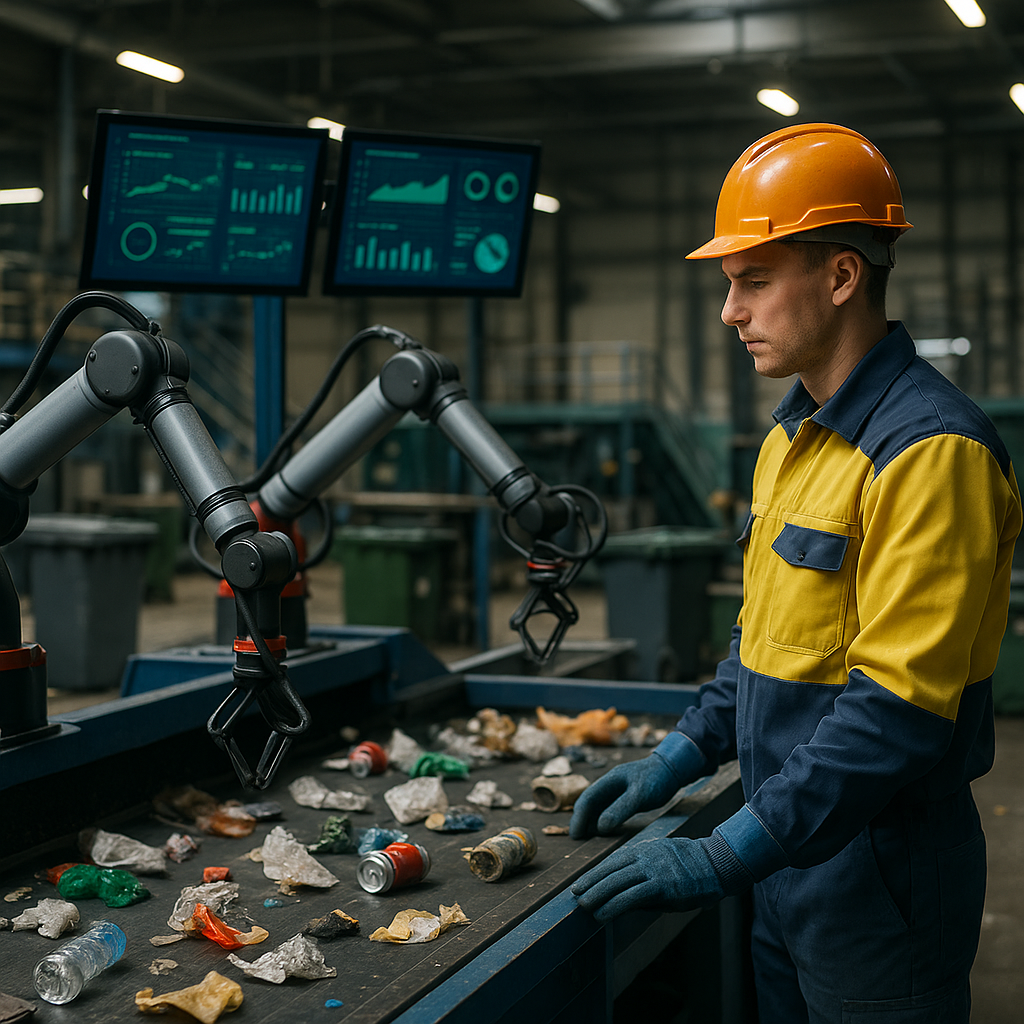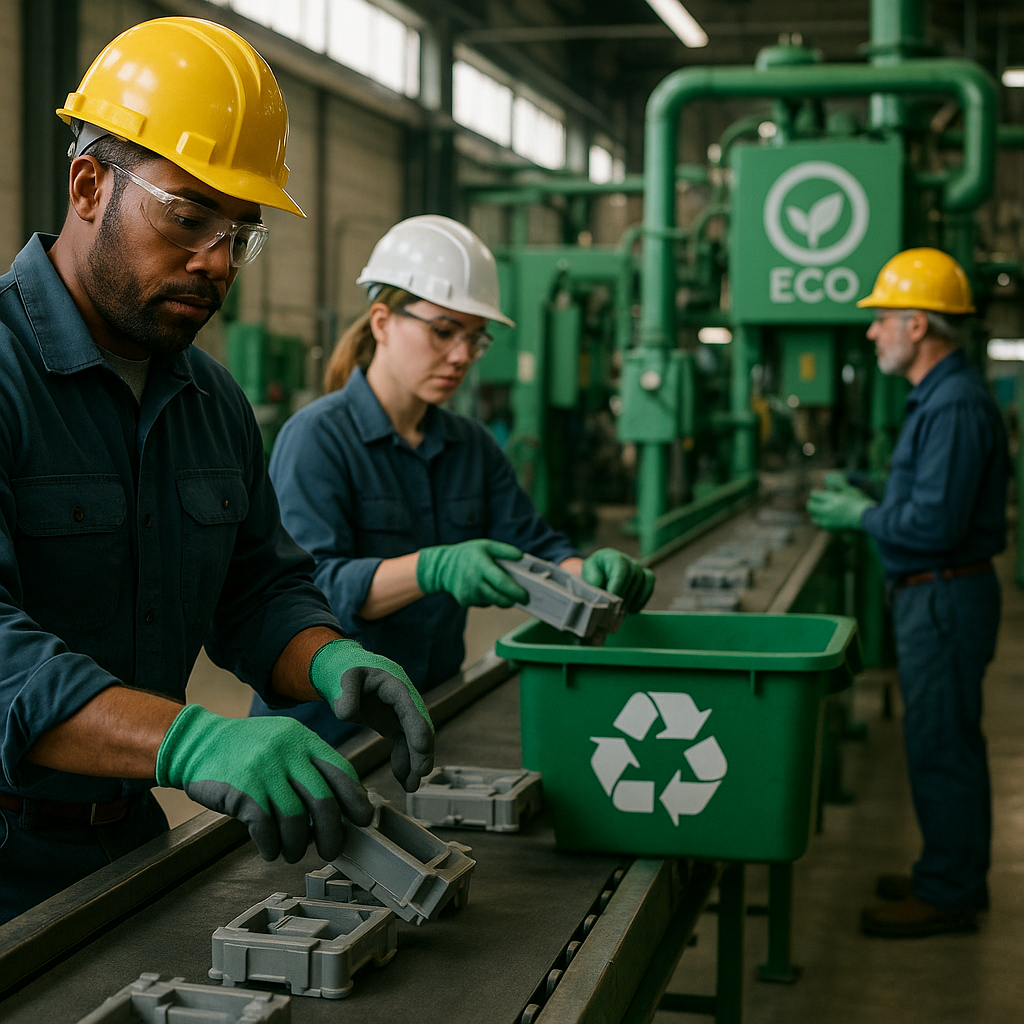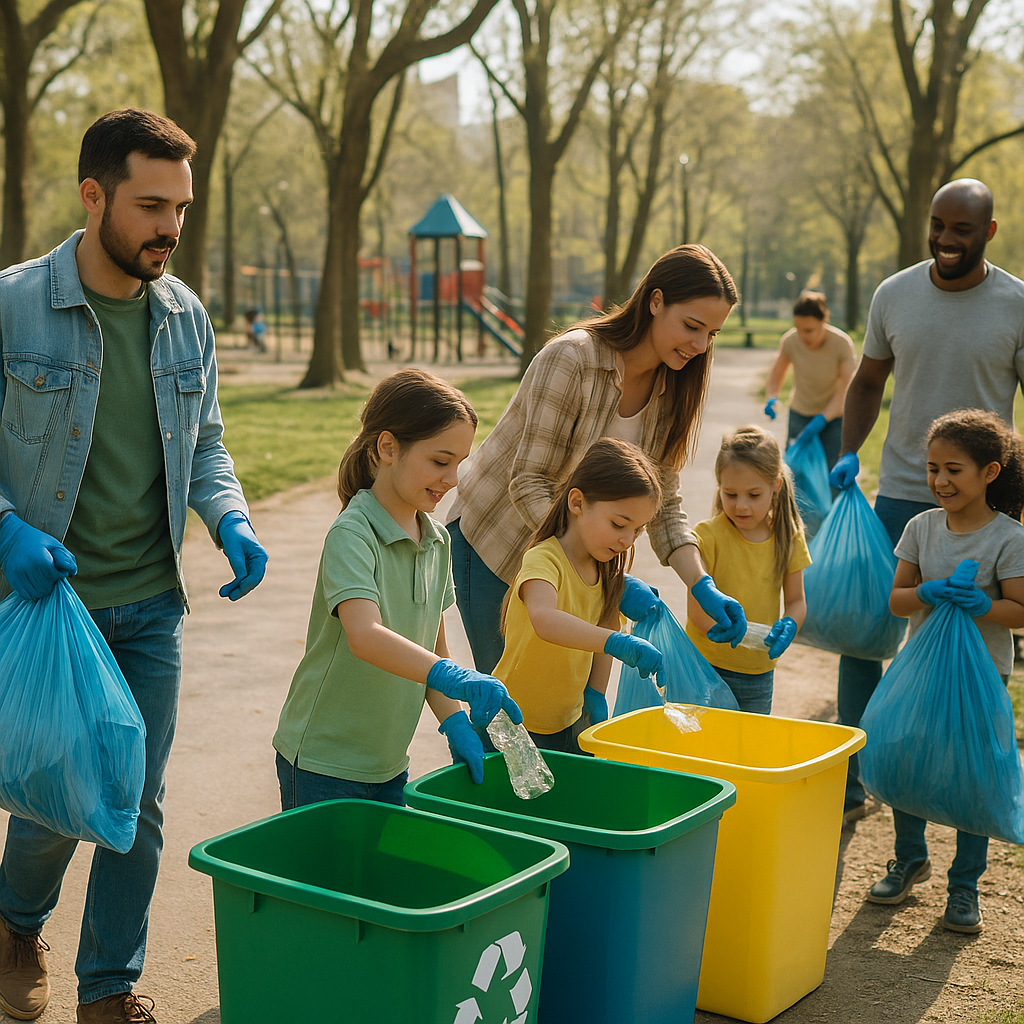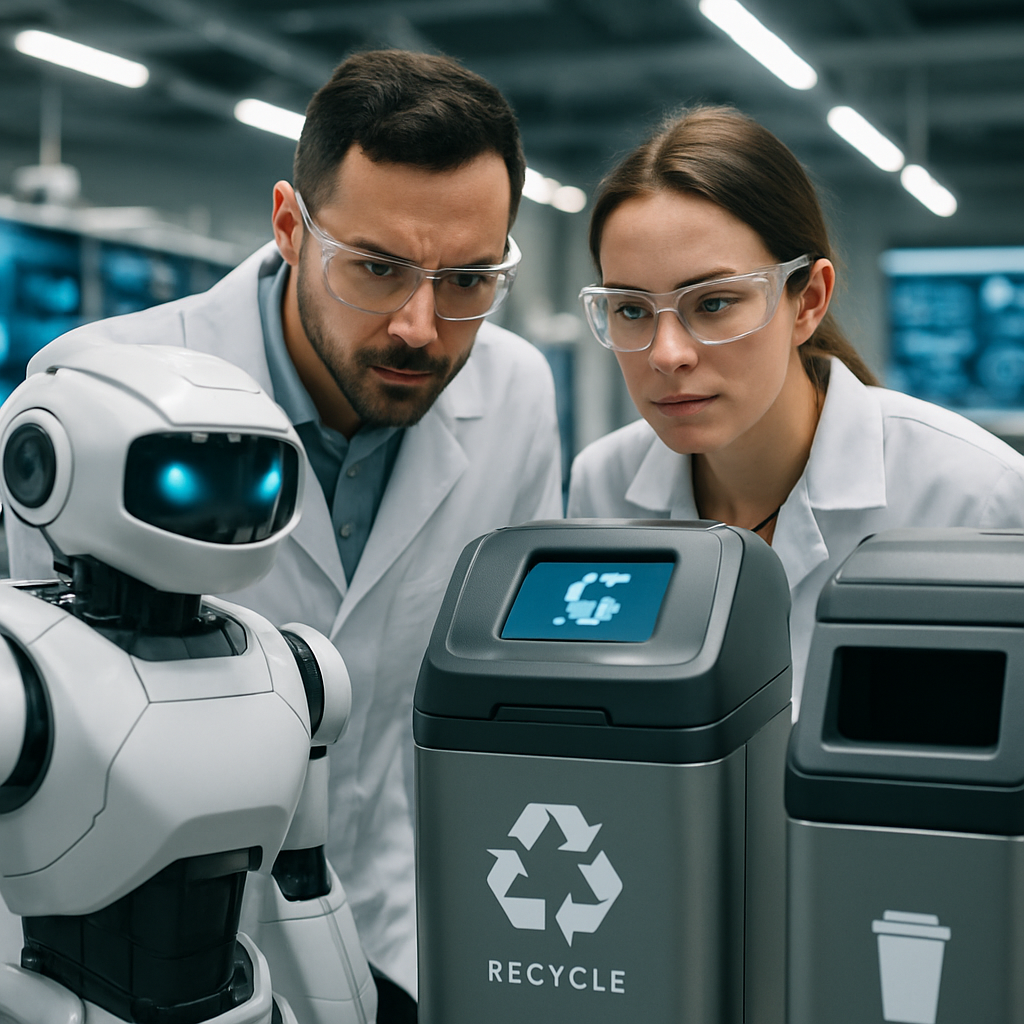5901 Botham Jean Blvd, Dallas, TX 75215
The Future of Waste Management: AI, IoT, and Circular Economy Solutions Explained
August 21, 2025Over 2 billion tons of waste are produced globally each year, a figure expected to rise to 3.4 billion tons by 2050. The mountains of garbage we generate present significant threats to our environment, public health, and climate stability.
Traditional waste disposal methods are becoming increasingly unsustainable. Landfills emit harmful greenhouse gases, with methane being particularly concerning as it traps heat 28 times more effectively than carbon dioxide. Currently, only 13.5% of global waste is recycled, highlighting an enormous potential for resource recovery and environmental protection.
The need for innovative waste management solutions arises not only from increasing waste volumes but also from their changing composition. Electronic waste, plastics, and industrial byproducts present unique challenges that conventional systems cannot handle. Forward-thinking approaches that incorporate smart technologies, circular economy principles, and sustainable practices are essential to transform waste management. These solutions promise to reduce environmental impact, create economic opportunities, and build resilient communities prepared for future challenges.
How Are Modern Technologies Revolutionizing Waste Management?

Artificial intelligence (AI) and Internet of Things (IoT) technologies are fundamentally reshaping waste management practices. Smart sensors embedded in waste bins monitor fill levels in real-time, automatically alerting collection services when bins approach capacity. This innovation eliminates unnecessary collection trips, reducing fuel consumption and operational costs by up to 30% in many municipalities.
AI-Powered Sorting
AI-powered sorting systems represent one of the most significant advances in recycling technology. These systems use computer vision and machine learning algorithms to identify and categorize waste materials with remarkable precision. Traditional sorting facilities once relied heavily on manual labor, resulting in slower processing and higher contamination rates. Modern AI sorting robots can distinguish between various types of plastics, metals, and other recyclables at speeds far exceeding human capabilities.
For example, optical sorting technology uses near-infrared sensors to detect different polymer types, enabling facilities to separate PET from HDPE plastics with over 95% accuracy. This technology is particularly valuable for processing mixed recycling streams, where contamination has historically been a major challenge. Some advanced systems can even detect and remove non-recyclable items that would otherwise compromise batch quality.
Route Optimization
Route optimization is another crucial application of these technologies. IoT-enabled waste management systems gather data from various collection points to generate dynamic collection schedules. Instead of following fixed routes, waste collection vehicles can focus on areas with the highest need. This data-driven approach increases operational efficiency and significantly reduces carbon emissions from collection vehicles.
Predictive Analysis
Smart waste collection is further enhanced by predictive analytics. AI algorithms analyze historical data alongside variables such as seasonal trends, event schedules, and community demographics to forecast waste generation patterns. For instance, during major public events, waste generation often spikes temporarily. Predictive systems enable municipalities to proactively adjust collection schedules to accommodate these fluctuations, preventing overflow and maintaining cleanliness in public spaces.
Data Analytics
Data analytics also plays a vital role in waste management decision-making. The substantial information gathered from IoT devices provides city planners with insights into waste patterns, disposal habits, and collection efficiencies. This knowledge facilitates targeted improvements, from optimizing bin placement to developing community-specific recycling education campaigns. Municipalities can identify neighborhoods with lower recycling participation and implement tailored interventions to boost engagement.
Blockchain Technology
Blockchain technology, when integrated with IoT sensors, creates transparent and traceable journeys for recyclable materials from collection to final processing. This ensures that recyclables reach the proper processing facilities rather than being diverted to landfills. For consumers, this transparency builds confidence that their recycling efforts yield tangible outcomes, reinforcing commitment to sustainable practices.
Automation
Robotic automation in material recovery facilities (MRFs) has dramatically improved sorting efficiency. AI-powered robots with sophisticated grippers can identify, grasp, and sort items at rates exceeding 80 picks per minute. These systems work continuously without fatigue, significantly increasing throughput while reducing labor costs and workplace injuries associated with manual sorting.
In waste-to-energy facilities, IoT sensors monitor combustion processes in real-time, allowing operators to optimize parameters for maximum energy recovery and minimal emissions. This fine-tuning enhances energy efficiency while reducing the environmental footprint of waste processing operations.
Despite their transformative potential, implementing these technologies presents several challenges. The initial investment required for IoT systems can be substantial, from purchasing sensors to upgrading legacy infrastructure. Data security concerns must also be addressed to protect the information gathered by these interconnected systems. Additionally, technical expertise is needed for installation, maintenance, and data analysis, which may be lacking in some regions.
As these technologies continue to evolve and become more accessible, their impact on waste management will only grow. The combination of AI, IoT, robotics, and data analytics is creating more efficient, sustainable, and environmentally friendly waste management systems that benefit communities and ecosystems alike.
What Role Does the Circular Economy Play in Sustainable Waste Management?

The circular economy represents a significant shift in how waste management is approached. Unlike the traditional linear model of ‘take-make-dispose,’ circular systems keep materials circulating in the economy for as long as possible. This approach is gaining global momentum as organizations recognize its potential to address environmental challenges while creating economic value.
Fundamentals of Circular Economy in Waste Management
Circular economy principles transform waste management by treating waste not as a problem to discard, but as a resource to recover and reuse. Instead of focusing solely on disposal, circular systems prioritize resource recovery, material regeneration, and waste prevention.
The core principles include designing products for durability and recyclability, minimizing waste through better production processes, and creating closed-loop systems where materials continually cycle back into production. These methods reduce the need for virgin resources and cut greenhouse gas emissions associated with production and disposal.
Key Benefits of Circular Waste Management
The transition to circular waste management offers multiple benefits. Environmentally, it reduces pollution and conserves natural resources. With materials remaining in circulation, landfill pressure decreases, and there is less need to extract raw materials.
Economically, circular approaches create business opportunities and jobs in areas like refurbishment, remanufacturing, and recycling. Companies can cut costs by recovering valuable materials from waste and developing new revenue through innovative service models. Research suggests this could generate up to $4.5 trillion in annual economic output by 2030.
Social benefits include job creation across skill levels, from collection and sorting to high-tech recycling and product design. Communities benefit from reduced pollution and improved resource efficiency, particularly in cities facing waste management challenges.
Successful Real-World Applications
Worldwide, municipalities and businesses are adopting circular waste strategies with impressive results. Amsterdam, for example, has implemented citywide circular initiatives, including circular construction projects and reuse markets. The city aims to reduce new raw material use by 50% by 2030, showing how urban areas can lead the circular transition.
In the corporate sector, IKEA’s furniture take-back and refurbishment programs aim to make the company fully circular by 2030. This initiative not only reduces waste but provides affordable options for consumers and enhances brand loyalty through sustainable practices.
Renault has integrated remanufacturing into its business model, refurbishing automotive parts to reduce waste and raw material use, demonstrating circular principles’ viability even in resource-intensive industries.
Innovative applications are emerging in developing economies. In Ghana, efforts to improve urban waste management include supporting entrepreneurs building houses from recycled plastic waste, addressing both housing needs and plastic pollution.
Circular Product Design and Extended Producer Responsibility
Product design is central to circular waste management. Products designed with their end-of-life in mind are easier to repair, remanufacture, and recycle. This requires rethinking materials, assembly, and business models to ensure resources maintain value through multiple lifecycles.
Extended Producer Responsibility (EPR) policies complement circular design by holding manufacturers accountable for the entire lifecycle of their products, including waste. As more regions implement EPR regulations, companies are incentivized to create products that generate less waste and are easier to recycle. The Philippines recently passed legislation requiring large manufacturers to limit plastic packaging and pay for plastic waste management, exemplifying policy-driven circular transitions.
Challenges in Transitioning to Circular Waste Management
Despite its benefits, circular waste management faces challenges like cultural resistance, technological gaps in recycling, and complex supply chains. Infrastructure for collection, sorting, and processing needs development, requiring significant investment and stakeholder coordination.
Policy and economic incentives must support circular initiatives. Without supportive regulations and market signals, businesses may struggle to justify investments in circular systems despite their long-term benefits. Additionally, education is needed to help consumers and businesses understand their role in circular systems.
Developing economies face particular challenges in building necessary infrastructure while addressing immediate waste management needs. However, these regions also have opportunities to leapfrog to circular systems without the legacy constraints of established linear infrastructures.
The Future of Circular Waste Management
The future of waste management lies in increasingly sophisticated circular systems. Digital technologies like IoT sensors, blockchain for supply chain transparency, and AI-optimized routes will enhance efficiency and traceability. Smart waste management vehicles equipped with sensors and GPS tracking are already optimizing routes, improving collection efficiency, and reducing emissions.
Collaboration across sectors will accelerate innovation, with municipalities, businesses, and consumers working together to close material loops. Standardized designs, improved recycling technologies, and new business models will continue to emerge as the circular economy matures.
Ultimately, successful circular waste management systems will integrate multiple approaches—from improved design and consumer education to advanced recycling technologies and supportive policies. By viewing waste as a resource instead of a problem, we can transform our approach to materials and build more sustainable, resilient systems.
| Aspect | Linear Economy | Circular Economy |
|---|---|---|
| Resource Use | Take, make, dispose | Reuse, regenerate |
| Waste Management | Landfill and incineration | Recycling and remanufacturing |
| Business Model | Sell and dispose | Product-as-a-service, resale |
| Environmental Impact | High emissions and pollution | Reduced waste and lower carbon footprint |
| Economic Sustainability | Short-term gains, high costs | Long-term resilience, cost savings |
How Can Communities and Individuals Contribute to Better Waste Management?

Effective waste management requires active participation from everyone in society. When communities and individuals take responsibility for their waste, it leads to cleaner environments, reduced landfill usage, and conservation of natural resources. Here are some practical steps to make a significant difference in waste management efforts.
Implement Proper Waste Segregation
Waste segregation at the source is essential for effective waste management. Separating waste enhances recycling efficiency and reduces contamination of recyclable materials.
Communities can implement a three-bin system: one for recyclables (paper, plastic, glass, metal), one for organic waste (food scraps, yard trimmings), and one for non-recyclable waste. This system makes it easier for residents to sort their waste correctly.
Individuals can create designated collection points in the home for different types of waste, making segregation a daily habit. Label bins clearly and educate family members about proper sorting.
Embrace Composting for Organic Waste
Organic waste constitutes a significant portion of municipal solid waste. When sent to landfills, it decomposes anaerobically, generating methane, a potent greenhouse gas. Composting provides an environmentally friendly alternative.
Communities can establish centralized composting facilities or community composting hubs where residents can drop off organic waste. The resulting compost can be used in community gardens or distributed to local residents.
At home, set up a backyard compost pile or use a compact indoor composting bin. Food scraps, coffee grounds, eggshells, and yard trimmings can be transformed into nutrient-rich compost for your garden. This not only diverts waste from landfills but also creates a valuable soil amendment that enhances plant growth.
Support and Enhance Recycling Initiatives
Recycling diverts materials from landfills and reduces the need for raw resource extraction. Communities can improve recycling rates through various strategies.
Local governments can invest in advanced sorting facilities to enhance waste separation efficiency and accuracy. These technologies can handle larger volumes and recover more recyclable materials than manual sorting.
Communities should also provide convenient drop-off locations for items unsuitable for curbside bins, such as electronics, batteries, and hazardous waste. Regular collection events for these items can prevent improper disposal.
Individuals can support recycling by understanding accepted items in their local program and following guidelines closely. Remember, “wish-cycling”—putting non-recyclable items in recycling bins—can contaminate entire batches of recyclables.
Reduce Waste at the Source
While recycling is important, reducing waste generation is even more effective. Communities can promote waste reduction through policies and education.
Local governments can introduce plastic bag bans or fees, support package-free stores, and incentivize businesses to minimize packaging. Schools can incorporate waste reduction into curricula and practice it in cafeterias and classrooms.
Individuals can contribute by making conscious purchasing decisions. Buy in bulk to reduce packaging; choose products with minimal or recyclable packaging; and bring reusable bags, bottles, and containers when shopping. Repairing items instead of replacing them and donating usable goods instead of discarding them are also effective strategies.
| Type of Waste | Reduction Strategy |
| Industrial Waste | Use lean manufacturing principles to minimize excess processing and defects. |
| Chemical Waste | Enhance material efficiency and improve processes to generate less waste. |
| Construction Waste | Design processes for reuse of materials in the production cycle. |
| Plastic Waste | Encourage recycling and the use of biodegradable packaging materials. |
| Hazardous Waste | Implement waste minimization and pollution prevention plans. |
| Electronic Waste | Encourage take-back programs and refurbishment. |
Foster Education and Awareness
Education is crucial for effective waste management. Many want to manage waste responsibly but lack the necessary knowledge.
Communities can run awareness campaigns through social media, local newspapers, and community events. Schools can organize waste audits, recycling competitions, and field trips to recycling facilities or landfills to demonstrate waste impacts.
Neighborhood associations can host workshops on composting, waste reduction, and proper recycling. These events build community while spreading knowledge about sustainable waste practices.
For your household, stay informed about local waste management guidelines and share this information with family members. Set clear expectations and make sustainable waste management a shared responsibility.
Develop Public-Private Partnerships
Effective waste management often requires collaboration among government agencies, private companies, and community organizations.
Communities can partner with waste management companies to implement innovative collection and processing systems. Local businesses can sponsor recycling bins in public spaces or support community clean-up events.
Non-profit organizations can fill gaps in the waste management system by organizing collection drives for hard-to-recycle items or providing education about sustainable waste practices.
As an individual, volunteer with local environmental groups or participate in community clean-up efforts. Your involvement strengthens these partnerships and contributes to a cleaner community.
Support Sustainable Policies
Policy changes can effect systemic improvements in waste management. Communities should advocate for and implement policies promoting waste reduction, recycling, and proper disposal.
Pay-as-you-throw systems, where residents are charged based on the amount of non-recyclable waste they produce, can incentivize waste reduction and recycling. Extended producer responsibility policies require manufacturers to manage their products’ end-of-life disposal.
Individuals can support these policies by voting for candidates who prioritize sustainable waste management and participating in public forums on waste issues. Writing to local representatives about waste management concerns can also influence policy decisions.
Monitor and Improve
Continuous improvement is essential for effective waste management. Communities should track waste generation and diversion rates, using this data to refine their programs.
Regular waste audits can identify common contaminants in recycling streams or types of waste that could be diverted through new programs. Feedback mechanisms allow residents to report issues or suggest improvements to waste management systems.
At home, periodically review your waste management practices and identify areas for improvement. Challenge yourself to reduce your waste output over time, celebrating progress with your family or community.
What Are the Future Trends in Sustainable Waste Management?

The waste management industry is on the brink of a technological transformation. Emerging innovations promise to change how we process, recycle, and repurpose materials that would otherwise end up in landfills.
Waste-to-Energy Technologies
Waste-to-energy (WTE) conversion is one of the most promising developments in sustainable waste management. These technologies harness the energy potential in non-recyclable materials through thermal treatment processes.
Modern WTE facilities generate electricity and heat while significantly reducing the waste volume requiring disposal. The energy recovered can power thousands of homes and businesses, creating a valuable resource from materials that would otherwise contribute to landfill issues.
Advanced thermal treatment methods now produce fewer emissions than traditional incineration, making WTE increasingly viable as communities seek landfill alternatives that align with climate goals.
Biodegradable Packaging
The adoption of biodegradable packaging materials marks another shift in waste management practices. These materials break down naturally in composting environments, reducing long-term environmental impact.
Innovative companies are developing packaging from plant-based sources, including corn starch, mushroom roots, and seaweed. These alternatives offer similar performance to conventional plastics while decomposing harmlessly after use.
The transition to biodegradable packaging supports circular economy principles by ensuring materials return safely to the environment rather than persisting as pollution.
AI-Powered Recycling Systems
Artificial intelligence is enhancing recycling operations through improved sorting capabilities. Smart systems can now identify and separate materials with remarkable precision.
AI-driven optical sorters use machine learning algorithms to recognize different types of plastics, metals, and papers. This technology significantly improves recovery rates and reduces contamination in recycling streams.
The integration of robotics with AI creates automated sorting systems that operate faster and more accurately than traditional methods. These systems can work continuously without fatigue, dramatically increasing processing capacity.
Digital Waste Management Solutions
Smart waste management systems are transforming collection operations through real-time monitoring. Sensors installed in waste containers track fill levels and optimize collection routes.
These digital solutions reduce unnecessary truck movements and fuel consumption. Collection vehicles only visit locations where bins need emptying, improving efficiency and reducing emissions.
Data analytics from these systems provide valuable insights into waste generation patterns. Municipalities and businesses can use this information to develop more effective waste reduction strategies.
Potential Impact on Urban Environments
Future waste management technologies promise cleaner cities with reduced environmental footprints. Waste-to-energy facilities can process materials locally, eliminating long-distance transportation.
The combination of AI sorting and biodegradable materials will significantly reduce landfill requirements. This frees valuable land for other community uses while minimizing groundwater contamination risks.
Smart collection systems will make waste management less visible and intrusive in urban environments. Fewer collection vehicles and optimized routes mean less traffic congestion and noise pollution.
| Technology | Description | Benefits | Challenges |
|---|---|---|---|
| Pneumatic Waste Pipes | Waste is transported through pipes directly to processing centers. | Reduces garbage trucks, lowers emissions. | High installation cost. |
| Solar-Powered Trash Compactors | Compresses trash to increase bin capacity. | Fewer collection trips, reduces operational costs. | Limited to sunny locations. |
| AI Recycling Robots | AI-powered sorting of recyclables. | Increases sorting speed and accuracy. | High technology costs and maintenance. |
| E-Waste Kiosks | Kiosks for safe disposal of electronic waste. | Encourages recycling of electronics. | Limited kiosk availability. |
| Recycling Apps | Apps to guide users in recycling practices. | Promotes sustainable living. | Requires user engagement and smartphone use. |
These innovations collectively support a circular economy approach to resources. Materials continuously cycle through the system rather than following the traditional linear path to disposal.
As these technologies mature and become more widely implemented, they will reshape our relationship with waste. This transformation will move us closer to the ideal of zero waste communities, where all materials are reused, recycled, or converted to energy.
Conclusion: Paving the Way to a Cleaner, More Sustainable Future

Sustainable waste management is crucial for environmental preservation and resource conservation. As discussed throughout this article, achieving a cleaner future requires more than simply discarding waste. It calls for a fundamental change in viewing waste—not as an endpoint, but as a resource within a circular economy. By recycling, reducing waste generation, and adopting innovative waste-to-energy technologies, we can significantly decrease pollution, conserve natural resources, and lower greenhouse gas emissions.
The benefits of sustainable waste management extend beyond environmental protection to include economic advantages and community health improvements. By collectively embracing these practices, we can create a more sustainable world for future generations. For businesses and organizations seeking expert guidance in implementing effective recycling and waste management solutions, contact Okon Recycling at 214-717-4083.
